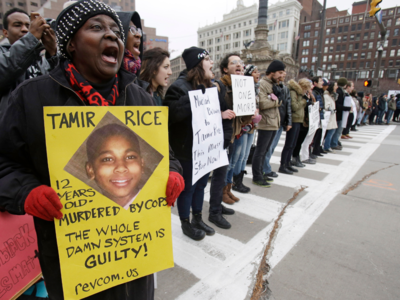[ad_1]

Demonstrators block Public Square in Cleveland, during a protest over the police shooting of 12-year-old Tamir Rice. File: AP Photo
ST. LOUIS: Timothy Loehmann wanted to be a police officer like his father. He got a job in Independence, Ohio, but his supervisors allowed him to quit after he suffered a “dangerous lack of composure” during firearms training.
Cleveland Police didn’t check on Loehmann’s history. So it was Loehmann who responded in the fall of 2014 to the Cleveland park where 12-year-old Tamir Rice was playing with what turned out to be a toy gun. Loehmann shot him dead.
“Wandering cops” who lose their jobs in one place only to be rehired pose a persistent roadblock to police accountability.
There is a straightforward solution, experts say:
– a national database open to the public with the names of all officers who have engaged in misconduct;
– a requirement that all law enforcement agencies consult that database before hiring.
A study of wandering officers in the Yale Law Journal last year found a problem bigger than expected. About 1,100 officers in Florida walk the streets having been fired in the past, 800 for misconduct.
A national database – the nonprofit National Decertification Index (NDI) – collects police decertification records from 45 states. It now has records on 30,172 officers.
But the database is badly flawed, experts say. Most departments don’t check it before hiring. The names in the database are not public. And, some of the biggest states in the country – California and New Jersey among them – are not in the system.
In St. Louis, wandering police are so common that there is a name for it – the Muni-Shuffle. St. Ann, a small suburb near Lambert Field, is a refuge for exiled officers.
One was Eddie Boyd III who as a St. Louis officer pistol-whipped a 12-year-old girl in 2006. He said it was an accident. In 2007 he struck a child in the face with his gun and handcuffs before falsifying a police report, according to state records.
St. Ann hired Boyd who shuffled his way to nearby Ferguson in 2012 and was on the force leading up to the death of Michael Brown. When a federal worker got in his car after a game of basketball, Boyd tried to cite him for not wearing his seat belt. Boyd drew his gun and pointed it at the man’s head when he used his cell phone.
Another St. Louis police officer who found refuge in St. Ann was Christopher Tanner who shot a former Black St. Louis officer Milton Green at Green’s home in 2017. A police chase sped into Green’s neighborhood while he was off-duty working on his car in his driveway. Tanner told him to drop her service revolver and immediately shot him.
Then there was Jonathan Foote, who resigned from the St. Louis Police Department after a traffic stop led to a crash where a bystander was killed – and Christopher Childers, fired from the St. Louis department after assaulting another officer by firing a stun gun at her.
St. Ann’s elected Police Chief Aaron Jimenez also hired officer Ellis Brown. Brown was forced out of the St. Louis department after he lied about a 2016 incident where he tailed a car, which accelerated, crashed and started burning. Brown left the scene instead of calling for help and then claimed he hadn’t been there.
In 2017 St. Ann hired Mark Jakob, one of two St. Louis County police officers fired for lying about a high-speed chase that ended in two deaths.
Chief Jimenez’s department favors aggressive tactics such as police chases. Despite its small size, St. Ann police conduct as many high-speed chases as the nearby St. Louis and St. Louis Police Departments that are 20 times bigger.
Roger Goldman, a professor emeritus at Saint Louis University Law School, isn’t surprised by St. Ann. He has spent a career crusading to stop wandering cops.
The crusade began 41 years ago when two bullets from Joseph Sorbello’s Bridgeton Terrace service revolver tore through the body of an alleged car thief in Maplewood, Mo.
Goldman remembered Sorbello had lost his police job in Maplewood in 1977 after it was disclosed he allegedly pointed his gun at a prisoner’s head in a one-way game of Russian Roulette – a game that resulted in another Maplewood police officer shooting Thomas Brown to death in the police headquarters that year.
How was it, Goldman wondered, that Sorbello had been hired by a neighboring department. Weren’t there safeguards against dangerous police, like dangerous doctors and lawyers. He found there weren’t and spent the ensuing decades getting police licensing laws passed in Missouri, Illinois and Indiana.
“My work is not anti-cop. It’s pro-good cop,” he says.
FacebookTwitterLinkedinEMail
[ad_2]
Source link